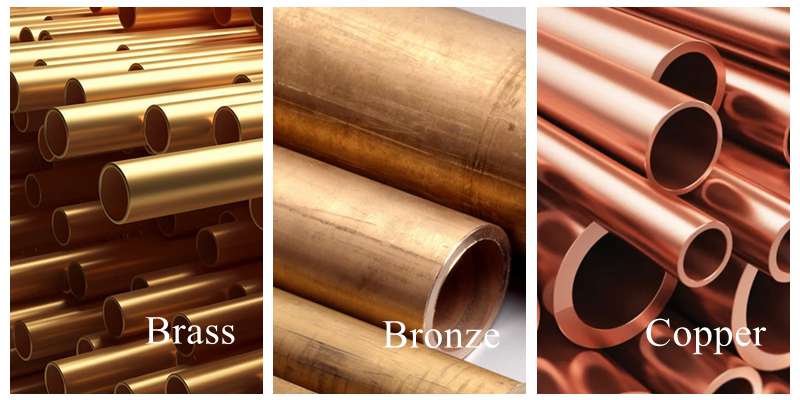- December 23, 2022
Brass, bronze, and copper are metallic materials with high electric/thermal conductivity, corrosion, and thermal resistance. They are applicable in several industry ranging from electronic, artwork, to architecture and machine.
Differentiating brass, bronze, and copper can be a challenging procedure due to several similar features. Therefore, this articles shows the difference between brass, bronze and copper, as it presents a well detailed evaluation on their properties and applications.
Differences Between Brass, Bronze and Copper
Brass, bronze, and copper belong to the same group called Red Metals. They have several similar properties although they also have several differences. Below are a few differences between brass, bronze, and copper that you can use to differentiate them:
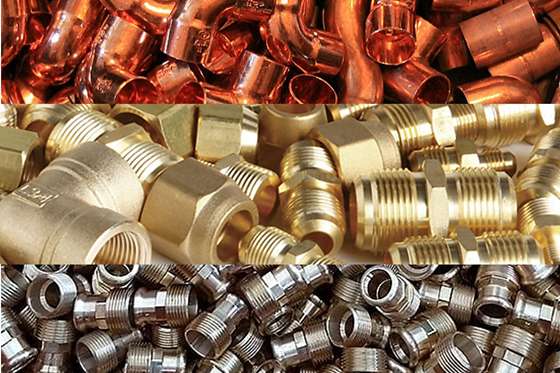
1. Element Composition
Among the three metals, copper is the only natural metal. It is a (non-ferrous) metal that occurs in its natural state and is directly utilizable for any compatible manufacturing processes. On the other hand, brass and bronze are alloys.
On the one hand, brass is an alloy of copper and zinc. It can also contain elements such as lead, manganese, iron, aluminum, and silicon. On the other hand, bronze comprises copper and tin as its main elemental components. Furthermore, it can also contain elements such as aluminum, nickel, phosphorus, and zinc.
2. Corrosion Resistance
Corrosion resistance is a common difference between brass, bronze, and copper. Bronze has strong corrosion resistance compared to the other two due to its ability to form a protective coat on exposure to a corrosive environment. As a result, it is very suitable for making parts used in the marine environment.
Copper also has quality resistance to corrosion and forms protective coatings. Compared to bronze and copper, the level of resistance to corrosion in brass is a bit lower.
In summary, out of the three metals, bronze has the highest level of corrosion resistance while Brass has the lowest resistance to corrosion.
3. Weight
Weight is another difference between brass, bronze, and copper. Here, copper has the highest weight (with a weight per volume of 8960kg/㎥. On the other hand, bronze (8800kg/㎥) and brass 8720kg/㎥) have similar lightweight densities although brass is the lightest.
In a weight ranking order, Copper> Bronze> Brass.
4. Durability
Bronze is a very strong material with a firm structure and hardly bends. Furthermore, its corrosion resistance, makes it highly durable. Copper likewise is durable, but is easier to work with than bronze. Furthermore, it is flexible and wears and tear-resistant.
Brass is more susceptible to cracks and scratches. In terms of durability, Bronze > Copper > Brass.
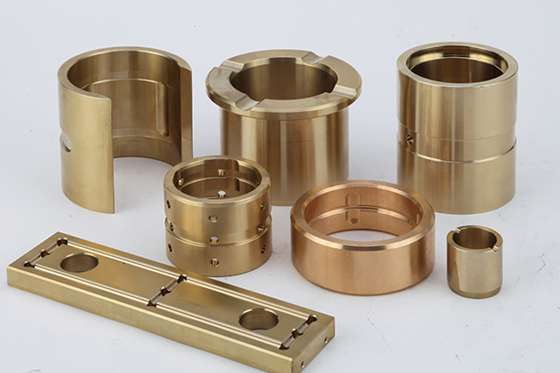
5. Machinability
When it comes to machinability, copper displays better machinability when compared to Brass and bronze. Moreover, copper machining has the highest flexibility among the three metals which makes common manufacturing procedures easier.
Bronze is more rigid making it less suitable for machining processes. Machining brass is the least machinable metal among the three options as it is not bendable and inflexible than bronze.
6. Weldability
The three metals are all weldable with no exceptions. However, oxygen-free copper and deoxidized copper have high weldability. The most common methods for welding copper are the MIG and TIG methods.
MIG, TIG, and silver soldiering techniques can also be used with alloys of brass. Metals containing a little amount of zinc are more weldable than those containing lead.
7. Conductivity (Electrical and Thermal)
Conductivity (electric and thermal) is an important factor when making comparisons between bronze vs brass vs copper.
Electrically, copper has high electrical conductivity (100%). However, brass has about 28% electrical conductivity while bronze has the lowest electrical conductivity (about 15%) due to the lower copper composition.
In summary, Copper > Brass > Bronze in terms of electrical conductivity.
Thermally, bronze has the highest thermal conductivity followed by copper while Brass has the lowest thermal conductivity among the three. This means that Bronze > Copper > Brass
8. Strength (Tensile and Yield strength)
Bronze is a more suitable material for projects that require high tensile and yield strength due to its high tensile and yield strength. Brass is the next in line while copper has the least tensile and yield strength value.
9. Appearance
Selecting between brass, bronze, and copper based on appearance can be quite complicated due to their physical looks.
Based on colors, differentiating between bronze and brass is somewhat easy. Brass has a yellowish-golden color while bronze has a reddish-brown color. Copper and bronze have similar reddish-brown brown colors but the shade of copper is displayed by pinkish orange coloration while that of bronze has a shade of dull gold.
10. Hardness
According to values on the Brignell hardness scale, bronze is the hardest metal out of the three options followed by brass than copper.
- Copper: 39
- Brass: 55-73
- Bronze: 40-420
Basic Overview of Copper
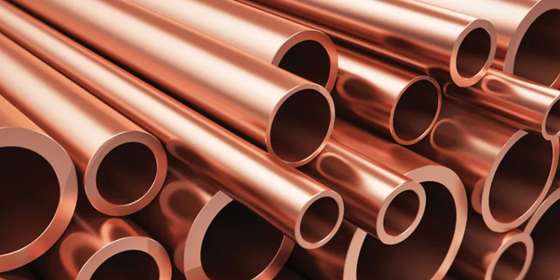
Copper is a naturally occurring non-ferrous metal widely applicable in several manufacturing industries because of its excellent properties. It is highly conductive alongside some unique properties of copper that include:
- Electrical conductivity
- Ductile
- Machinability
- Excellent heat conductivity
- Microbial resistance
- Corrosion resistance
Grades of Copper
Copper is a versatile metal that’s available in numerous grades. The most common grades of copper include:
Alloy 101 which lacks oxygen makes it a good choice for projects requiring excellent ductility and conductivity.
Alloy 110 or electrolytic copper is known for being the alloy with the highest level of thermal and electrical conductivities. In addition, it also demonstrates quality formability and ductility.
Alloy 122 is very similar to alloy 110 and is known for higher weldability, malleability, machinability as well as other mechanical properties.
Alloy 145 or tellurium Copper contains tellurium which improves its electrical and thermal conductivity.
Applications of Copper
Copper in its pure form is applicable in making parts and products used in plumbing, roofing, industry, and in making electrical appliances.
Other industrial applications of copper include architectural components, plumbing, heat sinks, submarine components, electric motors, telecommunication equipment, etc.
Basic Overview of Brass
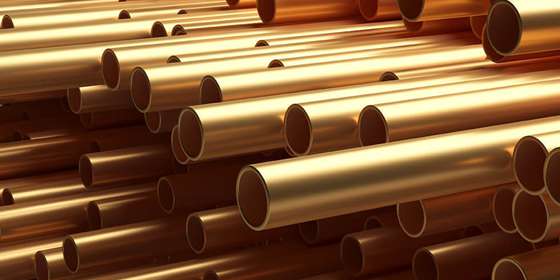
Brass is an alloy that contains two basic elements known as copper and zinc. It is a strong material with properties that include:
- Tarnish-resistant
- Low-friction
- Malleable
- Easily machined
- Stress cracks
- Formability
Grades of Brass
Due to the components of brass, it has various alloys, some of which are:
Alloy 260 or the cartridge brass exhibits cold working features and is applicable in making parts used in ammunition, hardware, etc.
Alloy 272 or the yellow brass has a higher percentage of zinc(about 33%) which increases its weldability.
Alloy 330 has a low quantity of lead and is highly machinable. Hence, its application in the pipeline industry.
Alloy 353 clock brass is known for its good machinability. It is applicable in making parts used in assembling wristwatches, clocks, etc.
Alloy 360 or free-cutting brass shows topnotch malleability and machinability making it suitable for the production of fasteners, valves, fittings, etc.
Alloy 385 or architectural brass has high structural integrity making it suitable for parts used in construction and architectural systems.
Alloy 464 or naval brass is a special alloy named because of its application in the marine environment. It is resistant to corrosion regardless of its temperature and also supports various processes like heading, soldering, welding, etc.
Applications of Brass
Brass looks similar to various tints of gold and has various applications. Common examples of the material include:
Musical Instruments: Brass is the most suitable metal for manufacturing parts of musical instruments.
Fittings: The unmatched properties of brass make it suitable for making fittings for parts.
Other applications of brass are plumbing materials, clock and watch fabrications, jewelry, door trim, etc.
Basic Overview of Bronze
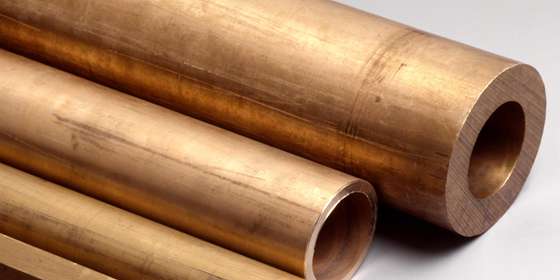
Bronze is a yellowish-brown alloy made from copper and Tin based alloy and other elements which includes aluminum, manganese, silicon, and phosphorus in little amount. It has the following properties:
- Ductility
- Melting point
- Hardness and brittleness
- High melting point
- High corrosion resistance
- Low metal-to-metal friction
Grades of Bronze
Based on the elements comprising bronze, the following are varieties of bronze:
Alloy 932 contains high-leaded tin and is mostly for manufacturing washers, bushings, etc.
Alloy 954 or aluminum bronze is very strong due to the inclusion of aluminum. As a result, it is applicable for supporting and attaching industrial facilities.
Applications of Bronze
Bronze is useful in a variety of applications. Below is a list of the applications of bronze:
Bushes and Bearings: This is the most common application of bronze. It is used to make bushes and bearing for automobiles.
Marine Equipment: The excellent properties of Bronze makes it suitable for the manufacturing of marine devices like propellers, ship fittings, etc.
Other applications of bronze include electrical springs, oil rigs, Petroleum equipment, etc.
Quickly Tell The Difference Between Brass, Bronze, and Copper
The color and the sound produced by the three metals differ slightly and can be used to quickly spot the differences between them.
Color
Copper has a very reddish-brown appearance; brass has a vivid yellowish-gold appearance while bronze is having a shade of dull-looking gold.
Sound
To examine if the material is a Copper or a metal alloy, you can gently hit the metal on a surface. This will result in copper generating a very deep and low sound. On the other hand, bronze will make a sound higher in pitch than copper while Brass will produce a sound higher than bronze.
Bronze vs Brass vs Copper: Selecting The Right Material For Your Projects
As earlier mentioned, bronze, brass, and copper display different features. This is why you need to have the following in mind when choosing any of the three metals for your project.

Degree of Flexibility
Brass, bronze, and copper all show a high level of durability but they have different degrees of flexibility. When considering a high level of flexibility, naturally occurring copper is the best option. In terms of machining, consider bronze and brass.
General usage
Brass is popular for its high usage for purposes such as doorknobs and musical instruments because of low friction.
Bronze is the better material when manufacturing parts for marine applications because of its high resistance to salt water.
Copper is the better option for manufacturing of food flasks and food heaters because of its antibacterial properties.
Prices
The prices of each of the metals differ which is as a result of the many alloys available. when searching for a cheap metal to use, brass is the most suitable choice. Brass is cheap as a result of the high amount of zinc present in it. Bronze is the next in line while copper is the most expensive out of the three metals.
Choose WayKen for Your Metal Machining and Prototyping Projects
Brass, bronze, and copper are metals applicable in several manufacturing industries based on their properties. Several industries subject the materials to manufacturing and prototyping processes such as CNC machining services, die casting, etc.
At WayKen, you get access to a quality-focused product manufacturing process. Our experienced engineers are experts in metal machining, which can meet your various part production needs.
Additionally, we offer our services at a competitive price and short lead time. Contact us for more information to choose the right material for your parts and use the right manufacturing process.
Conclusion
Brass, bronze and copper are similar metals but have some advantages over the other based on properties related to their conductivity, ductility, machinability, strength. Although similar, the three metals differs. As a result, this article provided a well detailed comparison and difference between brass, bronze and copper and their applications
FAQs
Which is the hardest out of bronze, brass, and copper?
The hardest metal of the three is bronze. As a result of the hardness, it has a lower machinability
Why is brass often used instead of copper?
Brass has a lightweight and has the ability to undergo high pressures caused by sequential movements in CNC machines. In addition, it also conducts electricity well.
Which is magnetic among bronze, brass, and copper?
The three of them are generally not magnetic. However, bronze is slightly magnetic because of the presence of about 12% of nickel in it.

